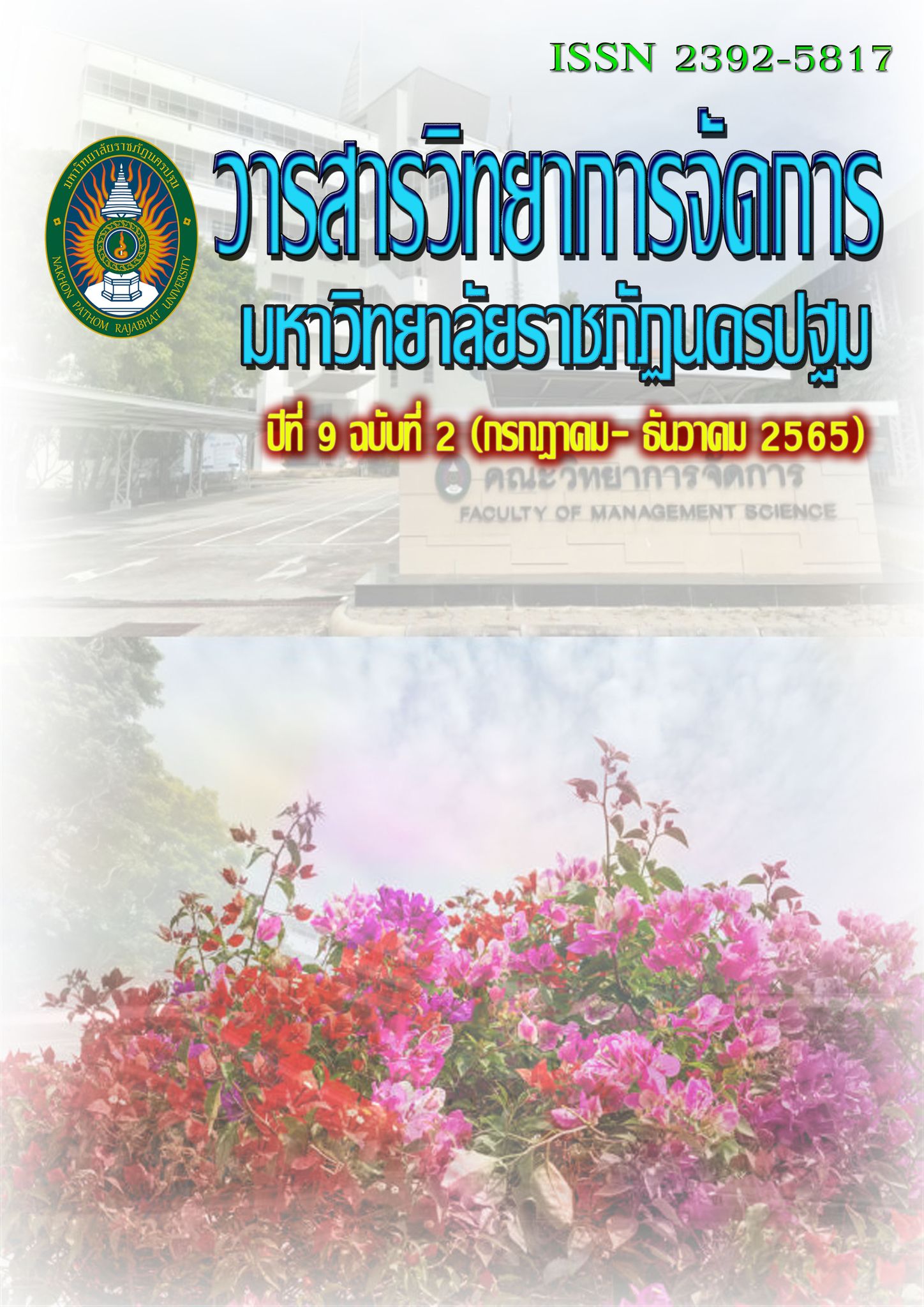The Causal Factors Influencing Competitiveness of Medium-Size Hotel in Thailand
Main Article Content
Abstract
The study focused to extend the capabilities of the competitiveness of medium-sized hotel in Thailand. The objectives of this research are, 1) to analyze the influence of factors affecting business transformation, competitiveness, and performance 2) to form a causal relationship to increase competitiveness, 3) to serve as a guideline to increase competitiveness of medium-size hotel in Thailand.
The study is a combination of quantitative analysis and qualitative analysis. Quantitative research uses a stratified sampling method. The sample size is determined according to Hair et al's formula. 380 mid-sized hotel operators are sampled from a total population of 4,570 hotels. The qualitative analysis uses a selective sampling technique, 15 operators and experts are sampled. Questionnaires are used to accumulate information.
The statistics expressed in this research are percentage, mean and standard deviation. LISREL program is used for analyzing the structural equation model. The study found that, for the medium-sized hotel business: fundamental resources, quality management systems, and government policy support influence hotel business transformation, competitiveness, and performance. Competitiveness influence business performance. The empirical evidence has six indexes that meet acceptance criteria those are 2/df = 1.214, CGI = 1.00, GFI = 0.98, AGFI 0.93, RMSEA = 0.026, and SRMR = 0.012. Thus, the study leads conclude that the structural equation model is appropriate and harmonious with the empirical data.
Article history: Received 30 March 2022
Revised 10 May 2022
Accepted 13 May 2022
SIMILARITY INDEX = 6.04 %
Article Details

This work is licensed under a Creative Commons Attribution-NonCommercial-NoDerivatives 4.0 International License.
The views and opinions of the article appearing in this journal are those of the author. It is not considered a view and responsibility of the editorial staff.
References
มาลินี สนธิมูล และอิทธิกร ขำเดช. (2557). ความพึงพอใจของนักท่องเที่ยวชาวต่างชาติที่มีต่อการใช้บริการโรงแรมระดับ 5 ดาว ในเขตกรุงเทพมหานคร. วารสารการเงิน การลงทุนการตลาดและการบริหารธุรกิจ, 4(2),204-217.
ศุภลักษณ์ สุริยะ และเทิดชาย ช่วยบำรุง. (2556).แนวทางการพัฒนาคุณภาพการบริการของแผนกต้อนรับส่วนหน้าโรงแรมเพื่อรองรับนักท่องเที่ยวอาเซียน กรณีศึกษา: โรงแรมบูติก กรุงเทพมหานคร. Ph.D. In Social Sciences Journal, 3(1), 5–18
ศูนย์วิจัยเศรษฐกิจและธุรกิจ ธนาคารกรุงศรีอยุธยา (2564) ธุรกิจ/อุตสาหกรรม ปี 2562-2564: ธุรกิจโรงแรม [ออนไลน์]. ค้นเมื่อ 6 ธันวาคม 2564 จาก https://www.krungsri.com/th/research/industry/industry-outlook/Services/Hotels/IO/io-hotel-21
Almor, T., Hashai, N. (2004). The competitive advantage and strategic configuration of Knowledge-intensive, small-and medium-sized multinationals: A modified resource based view. Journal of International management. 10(4), 479-500.
Amit R. & Schoemaker, P. J. (2012). Strategic assets and organizational rent. Strategies the Management theorie, 14. 325.
Andersen, P. & Ballingtoft, A. (2010). Cluster-based global firms use of local Capabilities. Management Research Review, 34(10),.1087 – 1106.
Baisya, R.K. (2010). Winning Strategies for Business. New Delhi: Chaman Enterprises.
Bakan, I. and Dogan, I.F. (2012). Competitiveness of the Industries Based on the Porter’s Diamand Model: An Empirical Study. IJRRAS, 11, 441-455.
Barney, J. B. (2012). Purchasing, supply chain management and sustained competitive advantage: The relevance of resource-based theory. Journal of Supply Chain Management, 48(2), 3-6.
Corbett, P. (2015). Business Transformation' needs a new definition. Retrieved November 7, 2020, from linkedin: https://www.linkedin.com/pulse/pulse/business transformation-needs-new- definition-peter-corbett
Eggert, A., Thiesbrummel, C., & Deutscher, C. (2015). Heading for new shores: Do service and hybrid innovations outperform product innovations in industrial companies? Industrial Marketing Management, 45, 173-183.
Freixanet, J. (2012). Export promotion programs: Their impact on companies' internationalization performance and competitiveness. International Business Review, 21(6), 1065-1086.
Hair, J.F., Black, W.C., Babin, B.J. and Anderson, R.E. (2010). Multivariate Data Analysis. 7th Edition, Pearson, New York.
Hinterhuber, A. (2013). Can competitive advantage be predicted? Towards a predictive
definition of competitive advantage in the resource-based view of the firm. Management Decision, 51(4), 795-812.
Huang, H.C., Lai, M.C., Lin, L.H. and Chen, C.T. (2013). Overcoming Organizational Inertia to Strengthen Business Model Innovation: An Open Innovation Perspective. Journal of Organizational Change Management, 26, 977-1002.
Kaplan, Robert S. & Norton, David P. (2006). How to Implement a New Strategy Without Disrupting Your Organization. Harvard Business Review. March: 100-109.
Kozlenkova, I. V., Samaha, S. A., & Palmatier, R. W. (2014). Resource-based theory in marketing. Journal of the Academy of Marketing Science, 42(1), 1-21.
Lechner, C., & Gudmundsson, S. V. (2014). Entrepreneurial orientation, firm strategy and small firm performance. International Small Business Journal, 32(1), 36-60.
Leonidou, L. C., Palihawadana, D., & Theodosiou, M. (2011). National export-promotion programs as drivers of organizational resources and capabilities: effects on strategy, competitive advantage, and performance. Journal of International Marketing, 19(2), 1-29.
Mahdi, O. R., & Almsafir, M. K. (2014). The role of strategic leadership in building sustainable competitive advantage in the academic environment. Procedia-Social and Behavioral Sciences, 129, 289-296.
Mankiw, N.G. (2008). Principles of Economics, (5th ed). South-Western College Publishing, Boston, MA.
McConnell, C.R., S.L. Brue, and S.M. Flynn. (2011). Economics: principles, problems, and policies, (19th ed.) New York: McGraw-Hill/ Irwin,
Penrose, E. T. (1995). The Theory of the Growth of the Firm. Oxford university press.
Porter, M E. (2011). Competitive advantage of nations: creating and sustaining superior performance. Simon and Schuster.
Postma, T.J., & Zwart, P. S. (2015). Strategic Research and Performance of SMEs'. Journal of small business strategy, 12(2), 52-64.
QuickMBA. (2010). Competitive advantage: Strategic management. Retrieved April 10, 2020, form http://www.quickmba.com/strategy/competitive-advantagel/
Ritthaisong, Y., M. Johri, L., & Speece, M. (2014). Sources of sustainable competitive advantage: the case of rice-milling firms in Thailand. British Food Journal, 116(2), 272-291.
Samuelson, P.A. & W.D. Nordhaus. (2004). Economics, (18th ed.) Boston: McGraw-Hill/Irwin.
Tukker, A. (2015). Product services for a resource-efficient and circular economy-a review. Journal of cleaner production, 97, 76-91.
Wu, J., & Chen, X. (2012). Leaders' social ties, knowledge acquisition capability and firm
competitive advantage. Asia Pacific Journal of Management, 29(2), 331-350.


